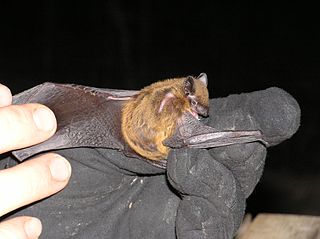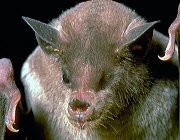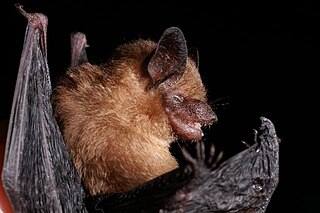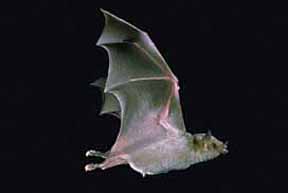 W
WThe eastern red bat is a species of microbat in the family Vespertilionidae. Eastern red bats are widespread across eastern North America, with additional records in Bermuda.
 W
WThe big brown bat is a species of vesper bat distributed widely throughout North America, the Caribbean, and the northern portion of South America. It was first described as a species in 1796. Compared to other microbats, the big brown bat is relatively large, weighing 15–26 g (0.53–0.92 oz) and possessing a wingspan of 32.5–35 cm (12.8–13.8 in). Big brown bats are insectivorous, consuming a diverse array of insects, particularly night-flying insects, but especially beetles. Some of the beetles it consumes are serious agricultural pests, including cucumber beetles. They are nocturnal, foraging for prey at night and roosting in sheltered areas during the day such as caves, tunnels, tree cavities, and human structures. Their breeding season is in the fall, shortly before their annual hibernation. After hibernation ends in the spring, females form maternity colonies for giving birth to young. Oftentimes only one offspring is produced per litter, though twins are common in the Eastern US. Lifespans of 6.5 years are considered average.
 W
WThe California myotis is a species of vesper bat. It is found in British Columbia in Canada, Guatemala, Mexico, and in the western United States, including California.
 W
WThe common vampire bat is a small, leaf-nosed bat native to Latin America. It is one of three extant species of vampire bat, the other two being the hairy-legged and the white-winged vampire bats. The common vampire bat practices hematophagy, mainly feeding on the blood of livestock. The bat usually approaches its prey at night while they are sleeping. It then uses its razor-sharp teeth to cut open the skin of its hosts and lap up their blood with its long tongue.
 W
WThe desert red bat, also known as the western red bat or southern red bat is a species of microbat found across the Americas. Lasiurus blossevillii is most often found in tree foliage, as is most in the genus Lasiurus, and is a solitary species.
 W
WThe evening bat is a species of bat in the vesper bat family that is native to North America. Hunting at night, they eat beetles, moths, and other flying insects.
 W
WThe ghost-faced bat is a bat in the genus Mormoops. It occurs in Belize, Colombia, Ecuador, El Salvador, Guatemala, Honduras, Mexico, Peru, Trinidad and Tobago, Venezuela, and Texas in the United States. Mormoops megalophylla is one of only two extant species within its genus, the other being the much smaller Mormoops blainvillii. These mammals are nocturnal and hunt using echolocation.
 W
WThe hoary bat is a species of bat in the vesper bat family, Vespertilionidae. It lives throughout most of North America and much of South America, with disjunct populations in the Galápagos Islands and Hawaii.
 W
WThe lesser long-nosed bat is a medium-sized bat found in Central and North America. It is sometimes known as Sanborn's long-nosed bat or the Mexican long-nosed bat, though the latter name is better avoided since it is also used for the entire genus Leptonycteris and for one of the other species in it, the greater long-nosed bat.
 W
WThe Mexican free-tailed bat or Brazilian free-tailed bat is a medium-sized bat native to the Americas, regarded as one of the most abundant mammals in North America. Its proclivity towards roosting in huge numbers at relatively few locations makes it vulnerable to habitat destruction in spite of its abundance. It has been claimed to have the fastest horizontal speed of any animal, reaching top ground speeds over 100 mph (161 km/h); its actual air speed has not been measured. The Texas Legislature designated the Mexican free-tailed bat the state mammal (flying) in 1995.
 W
WThe Mexican long-tongued bat is a species of bat in the family Phyllostomidae. It is monotypic within the genus Choeronycteris. The species is found in El Salvador, Guatemala, Honduras, Mexico, and the United States.
 W
WThe northern yellow bat is a non-migratory bat in the family Vespertilionidae, typically active year-round except during abnormally frigid winter weather, during which they will induce torpor.
 W
WThe pristine mustached bat is an extinct Late Quaternary species of bat in the endemic Neotropical family Mormoopidae. It was distributed in Cuba and possibly Florida.
 W
WRhogeessa is a genus of bats within the vesper bats family, Vespertilionidae.
 W
WThe Saussure's long-nosed bats or Mexican long-nosed bats form the genus Leptonycteris within the leaf-nosed bat family Phyllostomidae. Like all members of the family, they are native to the Americas. According to ITIS, three species are currently recognised, though varying placements of the populations into species and subspecies will be encountered. The species recognised by ITIS are:Southern long-nosed bat, Leptonycteris curasoae Greater long-nosed bat or Mexican long-nosed bat, Leptonycteris nivalis Lesser long-nosed bat or Mexican long-nosed bat, Leptonycteris yerbabuenae.
 W
WThe southern yellow bat is a species of vesper bat that belongs to suborder microchiroptera (microbat) in the family Vespertilionidae. It is native to South, North and Central America, from the Rio Grande Valley of Texas in the United States to Argentina.
 W
WVampire bats, species of the subfamily Desmodontinae, are leaf-nosed bats found in Central and South America. Their food source is blood, a dietary trait called hematophagy. Three extant bat species feed solely on blood: the common vampire bat, the hairy-legged vampire bat, and the white-winged vampire bat. All three species are native to the Americas, ranging from Mexico to Brazil, Chile, Uruguay and Argentina.
 W
WThe velvety fruit-eating bat, also known as Hart's little fruit bat, is a species of bat in the family Phyllostomidae. It is monotypic within the genus Enchisthenes. It is found in Central America, Mexico, the United States, and northern South America.
 W
WThe western mastiff bat, also known as the western bonneted bat, the greater mastiff bat, or the greater bonneted bat, is a member of the free-tailed bat family, Molossidae. It is found in the Western United States, Mexico and South America, and is the largest bat native to North America. The subspecies Eumops perotis californicus is a species of concern as identified by the U.S. Fish and Wildlife Service. The range of this subspecies is principally southwest desert regions of the United States, along the border with Mexico; however, the range extends as far north on the Pacific coast to Alameda County, California.
 W
WThe Yuma myotis is a species of vesper bat native to western North America.